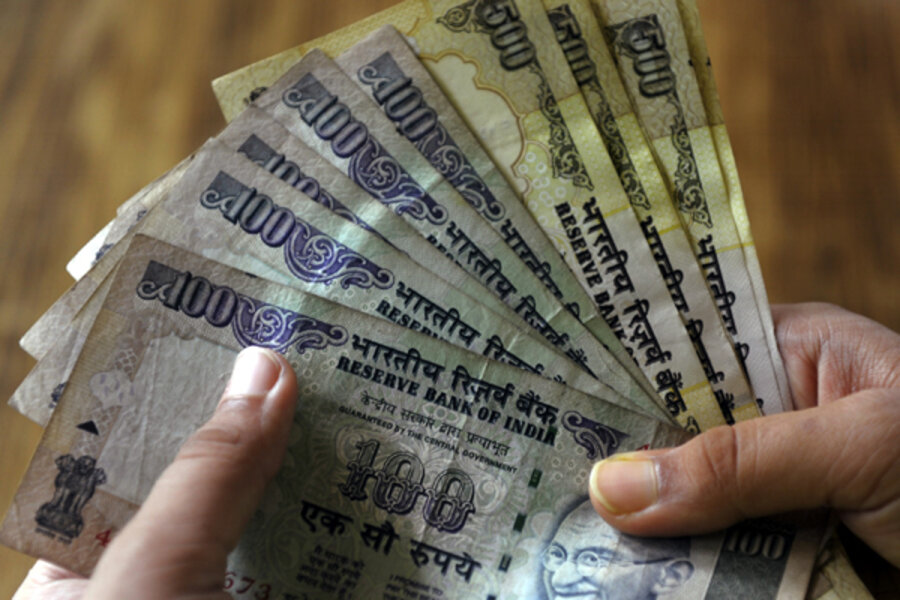India's new currency symbol puts rupee in the money
Loading...
| New Delhi
India now has its own version of the dollar sign.
The Finance Ministry held a nationwide contest this year to design the symbol that will represent the country’s currency, the rupee. The Indian government gave its seal of approval today to the winning entry.
Take a capital roman letter “R,” subtract the vertical spine, and add some Euro-like horizontal lines at the top. The character also resembles the “Ra” character in India’s clothesline-looking script known as Devanagari. The new symbol, therefore, has both Indian and international flavor.
Until now, the most common notation for the rupee was “Rs.” The problem is that a number of countries – including archrival Pakistan – also have a rupee, leading international traders to rely on the clunky “INR” to distinguish it.
The creation of the new symbol represents India’s assertion of importance as a major international market, one whose currency warrants a special moniker, not just a jumble of letters.
"With this, India will join an elite group of countries which have a distinct currency symbol. It denotes the robustness of Indian economy," said Ambika Soni, the Minister for Information and Broadcasting.
New rupee notes and coins will bear the symbol, as no doubt will Indian keyboards, shops, and currency stalls.
More important will be the extent to which the symbol will gain international usage and cache. Experts see this as an important branding opportunity for the wider Indian economy among international investors.
“This is yet another symbol of the coming of age of India as a major player in the world economy,” says Surjit Bhalla, managing director of Oxus Research and Investments, a New Delhi-based economic research firm.
“It’s probably more aspirational,” he adds, but “in 1990, if India said we’ll have a rupee symbol, people would have laughed at it. Today, people are asking how important it is.”
This branding effort is aimed at burnishing the reputation of the country’s overall economy, not the currency itself per se. Few expect the fancy character to suddenly turn the rupee into the kind of haven that the dollar or euro represents on currency exchanges.
The rupee has grown increasingly stable in value. Versus the dollar, it made strong gains until the global flight to the dollar at the height of the worldwide financial crisis. The rupee quickly recovered – it now sits at 46.5 to the dollar – reflecting the Indian economy’s quick rebound. The International Monetary Fund forecasts GDP growth of 9.5 percent this calendar year while Western nations remain mired in economic doldrums.
Mr. Bhalla sums up India’s pitch: “You have a nondepreciating currency with a high-growth rate, and you know what? There is even a symbol to go with it.”
For Harish Bijoor, a brand and business strategy consultant in Bangalore, the new character is “a way of saying we are entering into the realm of the developed world.”
But India’s double digit inflation, he says, “is the soft underbelly of this new symbol.”
In June, that inflation reached 10.6 percent, piling on to double digit rates in May (10.2) and April (11.2). Street protests have erupted over rising food prices that have burdened some three-quarters of Indians who still live on less than $2. To get a handle on the problem, India’s central bank has raised interest rates three times since March.
Bhalla counters that India uses a different set of metrics to report inflation than the rest of the world. Using metrics common in the US, inflation will come out to around 4.5 percent for the second quarter of this year.
“It’s quite shocking we’ve allowed food inflation to scale the heights it has. But there’s no overall inflation problem,” he says.
Related stories:





